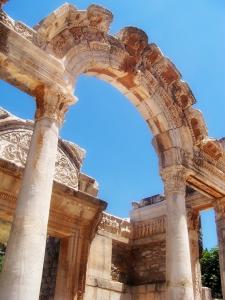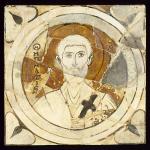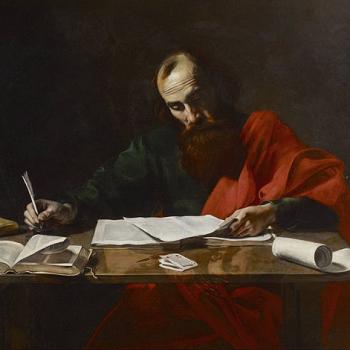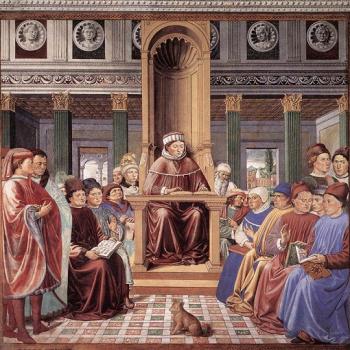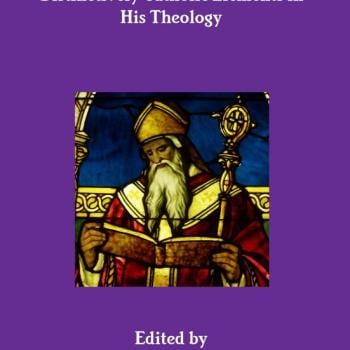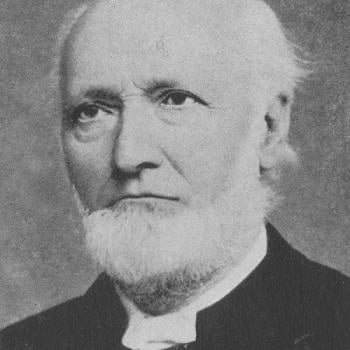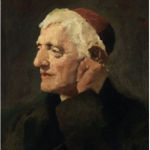It’s been argued that Jesus Himself, cited by St. John in the book of Revelation (written around 95 AD), taught monepiscopacy (the notion of one bishop overseeing a city or region). In Revelation 1:16, St. John states that he saw “seven stars” in Jesus’ right hand. Then Jesus explains in 1:20 that “the seven stars are the angels of the seven churches.” Then Jesus tells John seven times in Revelation 2 and 3 to write certain things “to the angel” of each church. The seven churches are as follows:
2:1 Ephesus
2:8 Smyrna
2:12 Pergamum
2:18 Thyatira
3:1 Sardis
3:7 Philadelphia
3:14 Laodicea
Many classic Protestant commentators and scholars of biblical Greek think this is describing a single bishop of each local church. For example, Ellicott’s Commentary states that the “generally adopted view is that the angel is the chief pastor or bishop of the Church.” Jamieson, Fausset, and Brown Bible Commentary concurs that it is “the bishop, or superintendent pastor.” Pulpit Commentary, while noting that the interpretation is “very much disputed” comments that “the common explanation that they are the bishops of the Churches is attractive on account of its simplicity.”
Henry Alford, in his Greek Testament Critical Exegetical Commentary wrote about Revelation 2:8: “in accordance with the idea of the angel representing the bishop, many of the ancient Commentators have inferred that Polycarp must have been here addressed.” Adam Clarke’s Commentary states that the “stars” are “the seven angels, messengers, or bishops of the seven Churches.” W. E. Vine’s Expository Dictionary of New Testament Words states that the Greek word angelos “is also used of a [human] guardian or representative in Rev. 1:20.” Likewise, Ralph Earle’s Word Meanings of the New Testament opines that angelos “is used for human messengers in Luke 7:24; 9:52; and James 2:25 . . . we feel that here it may possibly mean the pastors of the 7 churches.”
Vincent’s Word Studies opines that one of two possible takes is that “The angels are Bishops.” Philip Schaff, the renowned church historian draws the remarkable conclusion that “This phraseology of the Apocalypse already looks towards the idea of episcopacy in its primitive form, that is, to a monarchical concentration of governmental form in one person, bearing a patriarchal relation to the congregation.” John Wesley, in his Explanatory Notes, stated that “In each church there was one pastor or ruling minister, to whom all the rest were subordinate. This pastor, bishop, or overseer, had the peculiar care over that flock . . .” Evangelical scholar Colin J. Hemer accepts bishops here as one possible interpretation:
A choice is generally offered between (1) heavenly guardians of the churches, and (2) human representatives of them, generally their bishops. Three other principal variants deserve consideration: (3) that the ‘angels’ are personifications of the churches; (4) that they are literally human ‘messengers’; and (5) that the term is used in some complex and elusive way or at differing levels, so that we cannot expect to assign it a lexical equivalent that tells the whole story. (Letters to the Seven Churches of Asia in Their Local Setting, Sheffield: Sheffield Academic Press, 1989, p. 32)
Catholic apologist Joe Heschmeyer offered further commentary on this, posted to my Facebook page:
Jesus’ warning to the “angels” about their possible imprisonment and spiritual lukewarmness (see Rev. 2:5, 10) suggest that we’re not to understand these to be literal angels. They’re also not personifications of the churches, since Jesus explicitly says that “the seven stars are the angels of the seven churches and the seven lampstands are the seven churches” (Rev. 1:20). The stars/angels are clearly connected to the lampstands/churches, but are not the same as them.
The Septuagint translation of Malachi 2:7 (“the lips of a priest should guard knowledge, and men should seek instruction from his mouth, for he is the messenger of the Lord of hosts”) refers to the priest as an ἄγγελος, angel/messenger. So reading the seven “angels” (literally “seven messengers”) as the seven bishops makes the most grammatical and contextual sense.
He elaborates further in his book about early ecclesiology:
[H]ow can John be expected to write and deliver a letter to angels? . . . how could a purely spiritual being like an angel get arrested [2:10] or repent after growing lukewarm? [2:5] . . .
[T]hey don’t appear to be simply messengers: they are . . . praised or rebuked for the spiritual state of their respective churches. . . . the best reading is that these are the seven local bishops. (The Early Church Was the Catholic Church, El Cajon, California: Catholic Answers Press, 2021, 117)
St. Augustine in his Letter 43 commented on this:
[I]f He wished this to be understood as addressed to a celestial angel, and not to those invested with authority in the Church, He would not go on to say: “Nevertheless I have somewhat against you, because you have left your first love. Remember therefore from whence you are fallen, and repent, . . .” [Augustine cites Revelation 2:4-5] This could not be said to the heavenly angels, who retain their love unchanged, as the only beings of their order that have departed and fallen from their love are the devil and his angels.
St. Epiphanius believed the same, commenting on Revelation 2:6 in his Panarion (2:25): “John writes in the Lord’s name to one of the churches — that is, to the bishop appointed there . . .” So this shows that at least two of the Church fathers took this view. If this interpretation is followed (and I just cited eleven major Protestant commentators who hold it or note that it is a common or respectable exegetical opinion), then it would follow that the question of monepiscopacy was already settled in the inspired revelation of the New Testament, describing the ecclesial scene around 100 AD, and by the words of our Lord Jesus.
I thought it might be interesting to see what I could find about the history of each of the seven churches of Revelation 1-3 (all located in far-western Asia Minor, or Anatolia; i.e., present-day Turkey).
Ephesus
Ephesus was considered part of Greece. It’s mentioned 14 times in the NT outside of Revelation (in Acts, 1 Corinthians, and 1 and 2 Timothy), and also “Ephesians” occurs four times in Acts. Eusebius in his Ecclesiastical History (III, 4, 6) states that “Timothy, so it is recorded, was the first to receive the episcopate of the parish in Ephesus, . . .” St. Timothy, thought to have died in 97 AD, was with St. Paul in Ephesus, c. 54-57. Paul seems to be commissioning Timothy as the bishop in Ephesus in this passage (c. 64):
1 Timothy 1:2-5 (RSV) To Timothy, my true child in the faith: Grace, mercy, and peace from God the Father and Christ Jesus our Lord. [3] As I urged you when I was going to Macedonia, remain at Ephesus that you may charge certain persons not to teach any different doctrine, [4] nor to occupy themselves with myths and endless genealogies which promote speculations rather than the divine training that is in faith; [5] whereas the aim of our charge is love that issues from a pure heart and a good conscience and sincere faith.
Biblical proofs for four of the five duties of bishops that I wrote about in my first book, A Biblical Defense of Catholicism, were partially drawn from Paul’s two epistles to Timothy (perhaps indicating that some of these were Timothy’s own duties):
- Jurisdiction over priests and local churches, and the power to ordain priests: 1 Timothy 5:22; 2 Timothy 1:6.
- Special responsibility to defend the Faith: 2 Timothy 4:1-5.
- Power to rebuke false doctrine and to excommunicate: 1 Timothy 5:20; 2 Timothy 4:2.
- Management of Church finances: 1 Timothy 3:3-4.
The 1880 work, Cyclopedia of Biblical, Theological, and Ecclesiastical Literature by James Strong and John McClintock (“Timothy”) stated that he “was thus to exercise authority as the delegate of an apostle — a vicar apostolic rather than a bishop.” This seems to me to be both a distinction without a difference and a perhaps unintentional mini-argument for apostolic succession (an apostle appoints as leader of a local church a person who would remain such after he was dead; hence, bishops succeed apostles). The same work then makes a rather remarkable statement:
A somewhat startling theory as to the intervening period of his life has found favor with Calmet (s.v. “Timothee”), Tillemont (2, 147), and others. If he continued, according to the received tradition, to be bishop of Ephesus, then he, and no other, must have been the “angel” of that Church to whom the message of Re 2:1-7 was addressed. It may be urged, as in some degree confirming this view, that both the praise and the blame of that message are such as harmonize with the impressions as to the character of Timothy derived from the Acts and the Epistles. The refusal to acknowledge the self-styled apostles, the abhorrence of the deeds of the Nicolaitans, the unwearied labor, all this belongs to “the man of God” of the Pastoral Epistles. Nor is the fault less characteristic. The strong language of Paul’s entreaty would lead us to expect that the temptation of such a man would be to fall away from the glow of his “first love,” the zeal of his first faith. The promise of the Lord of the churches is in substance the same as that implied in the language of the apostle (2 Timothy 2, 4-6). . . . It must be remembered, . . . at the time of Paul’s death, Timothy was still” young,” probably not more than thirty-five; that he might, therefore, well be living, even on the assumption of the later date of the Apocalypse, and that the traditions (valeant quantum) place his death after that date. . . . the death of Paul may have made a great difference in the work of one who had hitherto been employed in traveling as his representative. The special charge committed to him in the Pastoral Epistles might not unnaturally give fixity to a life which had previously been wandering.
The 1939 International Standard Bible Encyclopedia (“Timothy”) takes a similar view:
Paul . . . tells us that he had left Timothy as his delegate or representative in Ephesus (1Ti 1:3); and soon thereafter he wrote the First Epistle to Timothy, in which he gave full instructions in regard to the manner in which he should conduct the affairs of the Ephesian church, until Paul himself should again revisit Ephesus: “These things write I unto thee, hoping to come unto thee shortly” (1Ti 3:14).
It then cites Theodor Zahn‘s 1909 work, Introduction to the New Testament (II, 34):
[I]n Asia Minor, where, although as early as the time of Revelation and the time of Ignatius, bishoprics were numerous and closely adjacent, the office always retained its local character. . . . Timothy was acting as a temporary representative of Paul in his apostolic capacity at Ephesus, as he had done earlier in Corinth, and in Thessalonica and Philippi (1Co 4:17; 1Th 3:2 f; Php 2:19-23).
Is this not an excellent and thoroughly biblical argument for bishops following apostles, in apostolic succession? They might first be — like Timothy — representatives of the apostles in given locations, and then after the apostles’ death, become their successors as bishops. I made a similar argument in my first book in 1996: “St. Paul appears to pass on his office to Timothy (2 Tim. 4:1-6), shortly before his death, around 65 A.D. This succession shows an authoritative equivalency between Apostles and bishops, who are the successors of the Apostles” (p. 256).
Onesimus — possibly the same man mentioned by Paul in Colossians 4:9 (“the faithful and beloved brother”) and Philemon 1:10 (“whose father I have become in my imprisonment”) is named as a bishop of Ephesus (presumably the successor of Timothy) by St. Ignatius of Antioch, who died c. 110-117:
I received, therefore, your whole multitude in the name of God, through Onesimus, a man of inexpressible love, and your bishop in the flesh, whom I pray you by Jesus Christ to love, and that you would all seek to be like him. And blessed be He who has granted unto you, being worthy, to obtain such an excellent bishop. (Letter to the Ephesians, 1; cf. 6)
Smyrna
Smyrna doesn’t appear in the NT outside of Revelation. St. Polycarp (c. 69 – c. 155-167) was a bishop there:
Polycarp . . . having in our own times been an apostolic and prophetic teacher, and bishop of the Catholic Church which is in Smyrna. (Martyrdom of Polycarp, 16; written by eyewitnesses of his death)
St. Ignatius of Antioch wrote a letter to Polycarp, which began with the words, “Ignatius, . . . to Polycarp, Bishop of the Church of the Smyrnæans, . . .” He died between 110 and 117. St. Irenaeus (130-202), in his Against Heresies (Bk III, 3, 3, 4), written around 180, stated that “Polycarp also was not only instructed by apostles, and conversed with many who had seen Christ, but was also, by apostles in Asia, appointed bishop of the Church in Smyrna, whom I also saw in my early youth, . . .” and referred to “men who have succeeded Polycarp down to the present time.” Tertullian, writing about bishops around 200 AD, wrote about “the church of Smyrna, which records that Polycarp was placed therein by John; . . .” (Prescription Against Heretics, 32).
If indeed he was appointed bishop by either “apostles in Asia” or by St. John, then this would be in the late first century and around the time that Revelation was written, and would bear witness that monepiscopacy had reached Smyrna by the end of the apostolic age. The Cyclopedia of Biblical, Theological, and Ecclesiastical Literature (James Strong and John McClintock) states in its article, “Polycarp”:
That John was one of the apostles referred to by Irenaeus there is not the slightest reason to doubt; and we are disposed, with Tillemont, to regard Philip, whom Polycrates of Ephesus (apud Euseb. Hist. Eccles. 5, 24) states to have ended his days in the Phrygian Hierapolis, as another of those with whom Polycarp had intercourse. We believe that intercourse with these apostles, and perhaps with some other old disciples who had seen Jesus Christ, is sufficient to bear out the statements of Irenaeus, and is not inconsistent with the general truth of the ancient narrative given by Bollandus. His statement of the ordination of Polycarp by the apostles may perhaps be reduced to the fact that John, of whom alone Tertullian (i.c.) makes mention, was among “the bishops of the neighboring churches,” who came, according to the narrative, to the consecration of Polycarp. This circumstance enables us to fix that consecration in or before A.D. 104, the latest date assigned to the death of the venerable apostle, and which is not inconsistent with the narrative.
Pergamum
Pergamum is not referenced in the NT outside of Revelation. Revelation offers a clue as to its possible first bishop:
Revelation 2:13 “I know where you dwell, where Satan’s throne is; you hold fast my name and you did not deny my faith even in the days of An’tipas my witness, my faithful one, who was killed among you, where Satan dwells.”
According to Eastern Orthodox tradition, Antipas was appointed the first bishop of Pergamum by St. John, during the reign of Domitian (81-96) or possibly Nero (54-68). The traditional accounts assert that Antipas was martyred during the persecutions of one of those two tyrants: burned alive at the temple of Artemis in a pagan bull-shaped altar incense burner, which represented the bull god Apis. Pergamum was one of the centers of worship of the Greek god Asclepius (or Aesculapius), and also of Zeus, Athena, and Dionysus. Hence, Jesus’ description of it as “where Satan dwells.”
The 4th century Apostolic Constitutions (see Bk VII, sec. 4, 46), on the other hand, states that Gaius was the first bishop. The third epistle of John was written to “the beloved Ga’ius, whom I love in the truth” (3 Jn 1:1), who may be the same person, and possibly the same man in one of four other references to “Gaius” in the NT. John wrote to him, “you do follow the truth” (1:3) and that “strangers . . . have testified to your love before the church” (1:5-6). It could be that both men were bishops there in the first century.
In any event, we have two exceptionally righteous men who were both mentioned in the NT in conjunction with St. John, described in words from Jesus and John not inconsistent with the possibility that one or both were bishops in Pergamum, with Christian traditions backing up each scenario. When the pagans persecuted Christians, they always went after the leaders, if possible. Hence, all of the original disciples, save John, were martyrs.
Thyatira
Revelation 2:20 But I have this against you, that you tolerate the woman Jez’ebel, who calls herself a prophetess and is teaching and beguiling my servants to practice immorality and to eat food sacrificed to idols.
Thyatira is only tangentially mentioned once outside of Revelation (Acts 16:14). Anglican bishop Christopher Wordsworth (1807-1885), younger brother of the post William Wordsworth, offers a very interesting and plausible theory about this passage, which assumes a bishop present at the time that John wrote:
Jezebel . . . is described as calling herself “a prophetess,” and as having children, i. e. disciples. See the use of this word texvía in 2 John i. 4. 13; 3 John 4.
Doubtless a female false Teacher (“hæretica fæmina,” says Tertullian, de Pudicit. c. 18) is here condemned, such as in the next age were Priscilla and Maximilla, the prophetesses of Montanus (Euseb. v. 14. 16. 18), and it is observable that Thyatira was infested by the ravages of Montanism (Epiphan. hær. 51; cp. Tillemont, ii. pp. 195-203). It has been remarked by S. Jerome (ad Ctesiphontem), as a characteristic of heresies, that their promoters have usually associated women with themselves in propagating them. Simon Magus had his Helena; Nicolas and Marcion had their female votaries. Apelles had his Philumena. Montanus, Arius, Donatus, were aided by women in their heretical and sectarian designs.
We are not able to ascertain whether this false prophetess was actually the wife of the Chief Pastor of Thyatira. The name Jezebel is doubtless a symbolical one, like Sodom and Egypt (xi. 8), and Babylon, as used in this book; and is adopted to characterize the wickedness of this false prophetess, making herself like to the Sidonian Queen, who perverted the Israelites to Idolatry, and destroyed the true prophets of the Lord (1 Kings xvi. 31; 2 Kings ix. 7) , and who, as almost all idolaters did, joined harlotry with false worship (1 Kings xviii. 19; xxi. 25).
This false prophetess, thus symbolically designated, may have been the wife of the Bishop. . . . If this false prophetess of Thyatira was the wife of the Angel of the Church, then by conniving at the wickedness of a wife like Jezebel, he made himself like unto Ahab, whom Jezebel his wife stirred up (1 Kings xxi. 25); and, if this was the case, here is a warning to Rulers of the Church, not to permit considerations of private affection to interfere with the discharge of public duty. “If the wife of thy bosom, or thy friend, which is as thine own soul, entice thee, thou shalt not consent unto him, neither shalt thou spare, neither shalt thou conceal him” (Deut. xiii. 6—8).
But perhaps the word wife is used figuratively here; as the word children is, and as the words “who commit fornication with her” are. And then the word wife would intimate that the Angel of Thyatira, by his weak connivance, and even overweening fondness for this false Prophetess, treated her as if she were endeared to him as his own partner. He, the Ruler of the Church of Thyatira, who was bound to love, and cherish, and protect that Church espoused to himself in a holy union in Christ, he, by his blind partiality and indulgence, made this false teacher to be as his own consort in spiritual wedlock, and he made himself a partner in her sins (1 Tim. v. 22).
This interpretation seems most in accordance with the strong and fervid language of the Apocalypse, where the faithful Church is called the wife of the Lamb (xix. 7; xxi. 9. Cp. Isa. liv. 6) . (The New Testament of Our Lord and Saviour Jesus Christ, in the Original Greek, with Introductions and Notes, Volume 4: The General Epistles, Book of Revelation and Indexes, 3rd Edition, London: Rivingtons, 1864, p. 177 [“310” of 591 in the index on the left])
If the sense “thy wife Jezebel” be right, the allusion must be to 1 Kings 21:25: there is some one (or something) at Thyatira who is, to the Angel of the Church, such a temptress as Jezebel was to Ahab. No doubt, if we suppose the Angel to be the Bishop, it is probable that his actual wife is intended; . . .*Who “Jezebel” was—whether a real woman, or a personification of a sect,—is almost equally doubtful on any view: but it seems simplest to suppose a real person.
Sardis
Sardis also doesn’t appear in the NT outside of Revelation. Melito of Sardis (c. 100 – c. 180) was a prominent bishop of Sardis, and was mentioned eight times by Eusebius, in Book IV of his Ecclesiastical History. The McClintock and Strong Biblical Cyclopedia (“Melito of Sardis”) wrote about him:
So little is known of his personal history that it cannot be determined at what date he was elevated to the episcopacy, though he probably held the bishopric when the controversy arose at Laodicea respecting the observance of Easter, which caused him to write a book on the subject. This took place under Marcus Aurelius, to whom Melito presented an Apology for Christianity, according to Eusebius, in his Chronicon, in AD. 169-170.
If he had become bishop there somewhere between the ages of, say, 35-50, then his episcopacy would have been only that many years removed from the apostolic age, and it is not unreasonable to suppose that he has a predecessor. Episcopal bishop Arthur Cleveland Coxe (1818-1896) wrote about him in a collection of the Church fathers:
Melito may have been the immediate successor of the “angel” (or “apostle”) of the church of Sardis, to whom our Great High Priest addressed one of the apocalyptic messages. He was an “Apostolic Father” in point of fact; he very probably knew the blessed Polycarp and his disciple Irenæus. (The Ante-Nicene Fathers: Translations of the Writings of the Fathers Down to A.D. 325, Volume 8, Alexander Roberts, Sir James Donaldson, editors, New York: Charles Scribner’s Sons, 1906, p. 750)
Bishop Wordsworth, mentioned in the previous section, wrote that he was “a successor, therefore, of one of the Seven Angels addressed in the Apocalypse” (Lectures on the Apocalypse, London: Rivington, 3rd edition, 1852, p. 14). A page at EarlyChurch.org on Melito states that he was “the only bishop of [Sardis] mentioned in the literary monuments of the first three centuries.” So apparently no one knows the name of the first bishop there, or possibly the first few before Melito.
But we can’t on that basis conclude with certainty that, therefore, there were no bishops in Sardis before Melito. If we follow the “angel = bishop” interpretation of Revelation 1-3, Jesus Himself thought there was a bishop in Sardis, c. 95 AD. And the analogy from the other six churches of Revelation 1-3 also make it quite plausible to believe that Sardis would have been no different.
Philadelphia
Philadelphia also isn’t mentioned in the NT outside of Revelation. St. Ignatius of Antioch (d. c. 110-117) referred to the bishop of Philadelphia several times in his epistle to the church in that city (notably, in his Greeting and chapters 1-2, 7), but for some reason doesn’t name him. International Standard Bible Encyclopedia (“Philadelphia”) asserts that “One of the Seven Churches of the Book of Revelation (Re 3:7 ff) was there, and it was the seat of a bishop.”
According to the 4th century Apostolic Constitutions (see Bk VII, sec. 4, 46), Demetrius was the first bishop of Philadelphia, purportedly appointed by St. John. If this is true, he may have been the same person mentioned in 3 John 12: “Deme’trius has testimony from every one, and from the truth itself; I testify to him too, and you know my testimony is true.”
Laodicea
Laodicea appears five other times in the NT outside of Revelation: in Colossians 2:1; 4:13, and the following passage:
Colossians 4:15-17 Give my greetings to the brethren at La-odice’a, and to Nympha and the church in her house. [16] And when this letter has been read among you, have it read also in the church of the La-odice’ans; and see that you read also the letter from La-odice’a. [17] And say to Archip’pus, “See that you fulfil the ministry which you have received in the Lord.”
The celebrated Anglican patristic scholar, Bishop J. B. Lightfoot (1828-1889) drew the conclusion from this passage that Archippus (whom St. Paul calls a “our fellow soldier” in Philemon 1:2) was a bishop or at least a presbyter in Laodicea. In his book, Saint Paul’s Epistles to the Colossians and to Philemon (London: Macmillan, revised, 1879), he stated:
[T]he Laodiceans were closely connected with the ae Colossians by local and spiritual ties. To the Church of Laodicea therefore, and to the household of one Nymphas who was a prominent member of it, he sends greeting. At the same time he directs them to interchange letters with the Laodiceans; for to Laodicea also he had written. And he closes his salutations with a message to Archippus, a resident either at Colossae or at Laodicea (for on this point we are left to conjecture), who held some important office in the Church, . . . (p. 36)
[A]fter a parting salutation to the Church of Laodicea St Paul closes with a warning to Archippus, apparently its chief pastor, to take heed to his ministry’. (p. 42)
Our Archippus held some important office in the Church . . . but what this was, we are not told. St Paul speaks of it as a ‘ministry’ . . . Some have interpreted the term technically as signifying the diaconate; but St Paul’s emphatic message seems to imply a more important position than this. . . . Another question too arises respecting Archippus. Where was he exercising this ministry, whatever it may have been? At Colossae, or at Laodicea? . . . in the Epistle to the Colossians his name is mentioned immediately after the salutation to the Laodiceans and the directions affecting that Church; and this fact seems to connect him with Laodicea. On the whole this appears to be the more probable solution. Laodicea was within walking distance of Colossae [about 10 1/2 miles west]. (p. 309)
According to the 4th century Apostolic Constitutions (see Bk VII, sec. 4, 46), Archippus was the first bishop of Laodicea. Markus Barth and Helmut Blanke, in their book, The Letter to Philemon (Grand Rapids, Michigan: Wm. B. Eerdmans Publishing, 2000, p. 257) state that “because diakonia and diakonos can as well mean any high or low function in God’s, Christ’s, the gospel’s, Paul’s, or a congregation’s service, Archippus may also have . . . [been] a ‘priest’ . . . or even a bishop.”
Related Reading
*
***
*
Practical Matters: Perhaps some of my 4,500+ free online articles (the most comprehensive “one-stop” Catholic apologetics site) or fifty-five books have helped you (by God’s grace) to decide to become Catholic or to return to the Church, or better understand some doctrines and why we believe them.
Or you may believe my work is worthy to support for the purpose of apologetics and evangelism in general. If so, please seriously consider a much-needed financial contribution. I’m always in need of more funds: especially monthly support. “The laborer is worthy of his wages” (1 Tim 5:18, NKJV). 1 December 2021 was my 20th anniversary as a full-time Catholic apologist, and February 2022 marked the 25th anniversary of my blog.
PayPal donations are the easiest: just send to my email address: [email protected]. Here’s also a second page to get to PayPal. You’ll see the term “Catholic Used Book Service”, which is my old side-business. To learn about the different methods of contributing (including Zelle), see my page: About Catholic Apologist Dave Armstrong / Donation Information. Thanks a million from the bottom of my heart!
*
***
Photo credit: Temple of Hadrian (2nd c. AD), in Ephesus; photograph by Gokhan Okur; used on the back cover of my book, Catholic Church Fathers: Patristic and Scholarly Proofs (Nov. 2007 / rev. Aug. 2013)
Summary: I examine what can be historically determined about the seven churches of Revelation 1-3 (around 95 AD), whose “angels” have been interpreted to be bishops.


